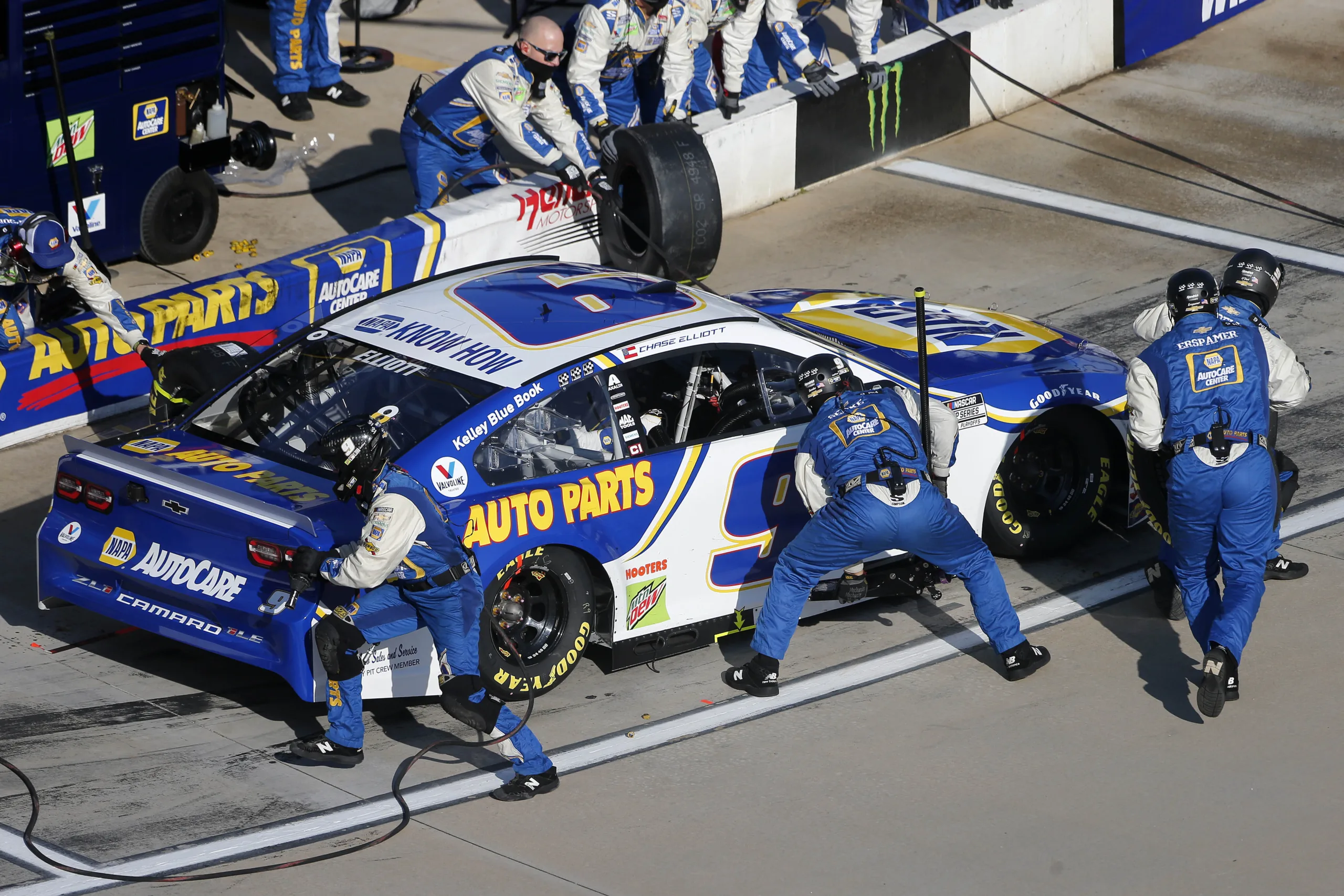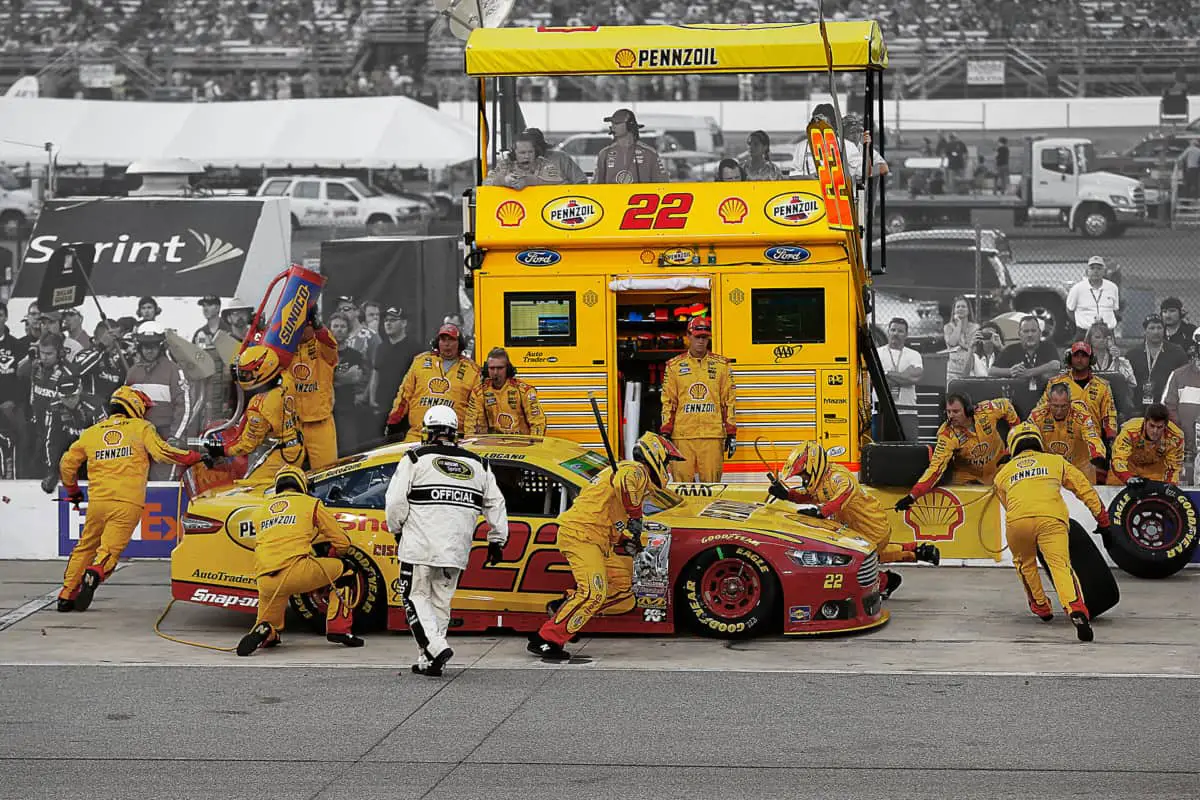If you are a fan of NASCAR, you probably know that pit stops are one of the most exciting and crucial parts of any race. They can make or break a driver’s chance at winning, as well as affect the overall performance and safety of the car. But do you know what goes on during a pit stop? How do the crew members change tires and add fuel so quickly? And what are the NASCAR pit stop rules and regulations that they have to follow? In this article, we will answer all these questions and more, as we explore the fascinating world of NASCAR pit stop rules and pit stops.

What is a pit stop and why is it important?
A pit stop is when a car leaves the racing track and enters the pit lane, where it stops at its designated pit box. There, a team of crew members will perform various tasks on the car, such as changing tires, adding fuel, adjusting the suspension, fixing damage, or cleaning the windshield. A pit stop usually lasts between 12 to 16 seconds, depending on how many changes are made and how well the team follows the NASCAR pit stop rules.
Pit stops are important for several reasons. First, they allow the car to replenish its fuel supply, which is essential for completing a long race. Second, they allow the car to replace its worn-out tires, which can improve its grip, handling, and speed. Third, they allow the car to make adjustments or repairs that can enhance its performance or safety. Fourth, they allow the driver to communicate with the crew chief and get feedback or instructions. Fifth, they can influence the race strategy and outcome, as different teams may choose different times or methods to pit according to the NASCAR pit stop rules.
The NASCAR pit stop rules are a set of guidelines and regulations that govern how teams can perform pit stops during a race. They cover aspects such as the pit road speed limit, the number of crew members over the wall, the tire and fuel control, and the pit box infringement. These rules are designed to ensure fair competition, safety, and consistency among all teams.

The basic procedure of a pit stop
A NASCAR pit stop starts with the driver coming off the track and down the pit lane. Nascar Drivers must adhere to the pit lane speed limit, which varies depending on the track but is usually between 35 to 55 mph. If they exceed the speed limit, they will incur a penalty.
Once the driver approaches the pit box, five crew members will jump over the wall to make the necessary changes to the car. These are:
- The jackman jacks up each side of the car so that the tires can be changed.
- The tire changer uses an air wrench to remove and replace the lug nuts and wheels on each corner of the car.
- The tire carrier brings the new tires over the wall and hands them to the tire changer, as well as takes away the old tires.
- The gasman inserts a fuel can into the car’s fuel tank and fills it up with gas.
- The utility man assists with various tasks such as cleaning the windshield, handing water or tools to the driver, or making minor adjustments.
The crew chief, who is in charge of the team’s strategy and decisions, watches over the pit stop from atop the pit box. He communicates with the driver via radio and tells him when to enter or exit the pit lane.
Once the crew has made all the changes and cleared out of the way, the driver will leave the stall. He must again adhere to the pit lane speed limit until he has re-entered the racing area.
The roles and responsibilities of the pit crew
The pit crew is a vital part of any NASCAR team. They are responsible for making sure that the car is in optimal condition during every race. They also have to work fast, efficiently, and accurately under immense pressure and stress.
The pit crew consists of several members, each with a specific role and duty. Here are some of them:
- Crew chief: The leader of the pit crew, the crew chief devises and executes the race strategy, making calls from atop the pit box. He also oversees the car’s setup and performance and communicates with the driver and the crew.
- Car chief: The second-in-command of the pit crew, the car chief is responsible for ensuring compliance and performance, overseeing every element of the car’s maintenance and operation throughout the race weekend.
- Spotter: The eyes and ears of the driver, the spotter is located high above the track and relays information to the driver about the traffic, conditions, and incidents on the track. He also helps the driver navigate the pit lane and avoid collisions.
- Engineer: The brains of the pit crew, the engineer analyzes data and provides feedback to the crew chief and the driver about the car’s performance, handling, and fuel mileage. He also helps with making adjustments and calculations during the race.
- Mechanic: In the hands of the pit crew, the mechanic works on the car before, during, and after each race, making repairs, changes, and inspections. He also assists with loading and unloading the car and equipment.
The rules and regulations of pit stops
NASCAR has a set of rules and regulations that govern pit stops. These are designed to ensure fair competition, safety, and consistency. Some of these rules are:
Pit road speed limit
As mentioned earlier, drivers must follow the pit road speed limit when entering or exiting the pit lane. NASCAR determines the speed limit based on the size and layout of each track. A sign at the entrance of the pit road usually displays it.
To measure the speed of each car, NASCAR uses a system of timing loops embedded in the pit road. Each car has a transponder that sends a signal to these loops as it passes by. By calculating the time it takes for a car to travel between two loops, NASCAR can determine its average speed.
If a car exceeds the speed limit by a small margin, it will receive a warning from NASCAR. If it exceeds the speed limit by a larger margin or receives multiple warnings, it will be penalized with a drive-through penalty. This means that the car has to drive through the entire length of the pit road without stopping at its pit box. This can cost a lot of time and positions for the driver.
Number of crew members over the wall
Each car can have up to five crew members over the wall and into the pit box during a pit stop. The only exception is when an accident or damage happens to the car. Then, one more person can help with repairs.
The crew members must wait until the car is completely stopped in its pit box before coming over the wall. They must also return to their side of the wall before the car leaves its pit box. If any crew member violates these rules, they will incur a penalty for their team.
Tire and fuel control
During a pit stop, each car must have all four tires changed at least once during a race. The tires must be approved by NASCAR and have a specific size, weight, and pressure.
The crew members must also control all tires throughout the pit stop. They must not let any tire rollout of their pit box or into another team’s pit box. They must also keep all tires within arm’s reach of their wall until they are ready to be used or removed.
Similarly, each car must have its fuel tank filled at least once during a race. The fuel must be approved by NASCAR and have a specific octane rating and composition.
The crew members must also control all fuel cans throughout the pit stop. They must not let any fuel leave their pit box or spill any fuel on the ground. They must also keep all fuel cans within arm’s reach of their wall until they are ready to be used or removed.
If any team violates these rules, they will incur a penalty for their team.
Pit box infringement
During a pit stop, each car must stay within its assigned pit box. The pit box is marked by two white lines on either side of it. The car must not cross these lines or touch any other car or equipment in another team’s pit box.
If a car infringes on another team’s pit box, it will incur a penalty for its team. The penalty may vary depending on the severity of the infringement. It may range from a warning to a drive-through penalty to a stop-and-go penalty. A stop-and-go penalty means that the car has to stop in its pit box for a certain amount of time before leaving.
How to perform a fast and efficient pit stop
A fast and efficient pit stop can give a driver an edge over his competitors in a NASCAR race. It can help him gain or maintain track position, save fuel or tires, or avoid trouble on the track. But how do teams achieve such quick and flawless pit stops? Here are some tips and tricks:
The importance of practice and coordination
One of the key factors that contribute to a fast and efficient pit stop is practice and coordination. The pit crew must practice regularly and rigorously, both in the shop and at the track, to hone their skills and timing. They must also coordinate with each other and with the driver, using clear and concise communication and signals.
Practice and coordination can help the pit crew avoid mistakes, such as dropping lug nuts, spilling fuel, or missing adjustments. They can also help them to optimize their movements, such as minimizing steps, synchronizing actions, or anticipating changes.
The factors that affect pit stop time
Another factor that affects the speed and efficiency of a pit stop is the various elements that can influence the time it takes to complete each task. Some of these elements are:
Track position and strategy
The track position and strategy of a driver can affect his pit stop time in several ways. For example, if a driver is leading the race or running in the front pack, he may have an advantage over other drivers who are behind him or in traffic. He may have a shorter distance to travel to enter or exit the pit lane, as well as a clearer path to his pit box. He may also have more options to choose when to pit, depending on the race situation.
On the other hand, if a driver is running in the back or in traffic, he may face more challenges during his pit stop. He may have a longer distance to travel to enter or exit the pit lane, as well as more obstacles to avoid or maneuver around. He may also have fewer options to choose when to pit, depending on the race situation.
Tire wear and fuel mileage
The tire wear and fuel mileage of a car can also affect its pit stop time. For example, if a car has worn-out tires, it may take longer for the tire changer to remove them from the wheel, as they may be stuck or damaged. It may also take longer for the tire carrier to bring new tires over the wall, as they may be heavier or bulkier.
On the other hand, if a car has low fuel mileage, it may take longer for the gasman to fill up its tank, as he may need more fuel cans or more time to insert them. It may also take longer for the driver to restart the engine, as he may need more cranks or pumps.
Caution flags and green flag stops
NASCAR pit stop rules can influence how fast a car can pit during a race, depending on the type of flag that is shown on the track. A caution flag means there is an incident or hazard, and most drivers will pit at the same time. This can make the pit road crowded and chaotic, and the pit crew may have to work faster and harder to avoid collisions or penalties.
On the other hand, if there is a green flag, which means that there is no incident or hazard on the track, some drivers may choose to pit at different times. This can create an opportunity and challenge for the pit crew, as they may have to adjust their strategy and timing according to their driver’s position and condition. It can also create uncertainty and risk for the driver, as he may have to deal with varying traffic and conditions on the track.
The fastest pit stops in NASCAR history
NASCAR pit stops are known for being fast and furious, but some of them are truly remarkable. Here are some of the fastest pit stops in NASCAR history:
The record for the fastest four-tire and fuel pit stop
The record for the fastest four-tire and fuel pit stop in NASCAR history belongs to Chase Briscoe and his team at Kansas Speedway in 2023. They completed the pit stop in 8.45 seconds. This was an amazing feat of speed and coordination by the crew.
The record for the fastest two-tire and fuel pit stop
According to the question answering results, the record for the fastest two-tire and fuel pit stop in NASCAR history belongs to Kyle Busch’s No. 8 Richard Childress Racing crew. They turned in a series-best stop of 9.185 seconds on June 11, 2023 at Sonoma Raceway. This was an impressive performance by the team, who also set the record for the fastest four-tire and fuel pit stop earlier this season.
The record for the fastest fuel-only pit stop
The record for the fastest fuel-only pit stop in NASCAR history belongs to the No. 2 team of Brad Keselowski. They achieved this feat on July 7th, 2012 at Daytona International Speedway during the Coke Zero 400 race. Brad Keselowski’s team completed the pit stop in a stunning 1.9 seconds, shattering the previous record of 2.4 seconds set by Jimmie Johnson’s team in 2010. They added 2 gallons of fuel to Keselowski’s car in less time than it takes to snap your fingers.
Conclusion
NASCAR pit stops are more than just routine maintenance. They are a complex and competitive art form that requires skill, speed, and strategy. They can make a huge difference in the outcome of a race, as well as the performance and safety of the car and the driver. By understanding the basics, rules, and records of NASCAR pit stop rules, you can appreciate them more and enjoy them better.
